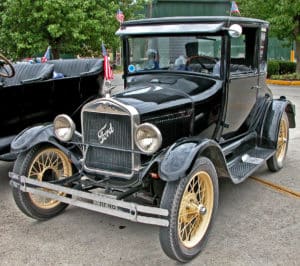1850-1900 | 1900-1910 | 1910-1930 | 1930-Present
As a Michigander, you’re probably aware that “The Big Three” automakers are headquartered in Michigan. What you might not realize is they all have a rich history in our state, and not just in the Motor City. We’ve compiled a timeline of the history of Ford, General Motors and Fiat Chrysler Automobiles around Michigan cities.
1850-1900
Origins Outside the Motor City
In the late 1800’s, while buggies still ruled the streets, engineering minds were tinkering with gasoline-powered vehicles. In 1886, Ransom E. Olds received a patent for the first car that ran on gasoline. He founded his first company, Olds Motor Vehicle Company, in Lansing 11 years later.
In 1899, Olds sold Olds Motor Vehicle Company and moved to Detroit to open Olds Motor Works, where he built the famous Curved Dash Oldsmobile.
Meanwhile, in Pontiac, Edward Murphy founded the Pontiac Buggy Company in 1893. He began producing cars 14 years later under a subsidiary called Oakland Motor Car Company.
1900-1910
Ford’s Birth in Detroit
Four years before the turn of the century, Henry Ford entered the auto scene in Detroit after building the famous quadricycle, his first gasoline-powered horseless carriage. He was a chief engineer at the Edison Illuminating Company at the time. He founded the Detroit Automobile Company along with financial backer William Maybury, Detroit’s mayor, and other investors in 1899. The company began to fail after less than two years in operation and Ford stayed for less than one. In 1901, Maybury and other financial backers helped him found the Henry Ford Company, which would also prove unsuccessful. In 1903, Ford founded Ford Motor Company, which produced its first car a month later. In only five years, the company launched the Model T, the first affordable car that would go on to transform the American way of life. By the end of 1927, the last year in production, Ford had sold 15 million Model Ts.
Cadillac
Out of the remnants of the Henry Ford Company came the birth of Cadillac Car Company in 1902. Henry Leland, a machinist, was called in to look at the failed company’s assets, and convinced them not to sell the company. After being founded in Detroit, Cadillac became known for its quality and was the leading luxury brand. Cadillac produced the first self-starting engine in the world and was the first to implement power steering and windshield wipers in every vehicle.
The Birth of Lansing’s REO Town
Olds sold his second company and moved back to Lansing to form REO Motor Company in 1904. He opened a factory and workers soon flocked to the area, which would become known as REO Town. Three years later, the company was one of the top four wealthiest automakers in America. The creation of General Motors a year later and the increasing competitive edge of Ford forced REO to lose market share. They continued production until 1975, focusing heavily on the production of trucks.
General Motors in the Vehicle City
Long before cars were on the road, Flint earned the nickname “The Vehicle City” for its abundant horse-drawn carriage production. 1886, William Durant founded the Flint Road Cart Company, later renamed the Durant-Dort Carriage Company, which would become the largest producer of horse-drawn carriages in America. Durant’s company sold carriages of all types and prices.
In 1903, David Buick incorporated Buick Motor Company in Detroit. The company was bought in 1903 by Flint Wagon Works and the company was moved to Flint. The company launched the Model B Buick that year, but was forced to turn to Durant due to financial troubles. He became the head of the company.
By 1908, Buick led the U.S. in automobile production. In the same year, Durant founded General Motors (GM) in Flint, acquiring Buick and Oldsmobile. His vision was to merge several powerful companies into one. Within two years, GM had acquired 30 companies, including Oakland Motor Car Company and Cadillac. The company’s board forced Durant to resign due to his rampant spending.
1910-1930
Chevrolet
Durant didn’t give up on his dreams of owning a successful car company. In 1911, he began to form Chevrolet with the help of retired Buick colleague and racecar driver Louis Chevrolet. They set up shop in Detroit and Durant returned to his old stomping grounds in Flint to buy Flint Wagon Works. He sought the help of another Buick colleague, Arthur Mason, who had built engines. Durant incorporated the Chevrolet Motor Company that November in Detroit.
Durant’s second company went on to be a success. In fact, with the help of investors like DuPont Company, Chevrolet bought enough GM stock to gain control of the company once again in 1915. DuPont backed GM and handled their finances. Durant attempted to expand GM for a second time, this time with his efforts clashing with dropping auto sales. DuPont saved GM from bankruptcy but Durant experienced his second ousting from the company in 1920. The GM founder managed a bowling alley in Flint until he died.
WWI
In the early years, cars were mainly a luxury that only the wealthy enjoyed. But Ford’s Model T wasn’t the only thing that changed the transportation game for the majority of the American population — the first world war also played a major role in normalizing cars.
Horses were still used heavily for battle and millions perished on the fields. The United Kingdom’s Vauxhall produced the Vauxhall D-Type, which began to be used by high-ranking officers and royalty for transportation outside of direct conflict. Even before the U.S. entered the war, Ford Motor Company’s British factories were making cars and trucks for the war effort. Many American car companies switched over the majority of their production towards making airplanes, engines, and vehicles equipped for battle.
By the end of the war, two out of every five vehicles in the United Kingdom were Fords.
Dodge
Brothers John and Horace Dodge opened a shop in Detroit to produce parts for automobiles. In 1901, Ransom Olds hired them to build the famous curved dash for the Oldsmobile. Soon after, the brothers had a contract with Henry Ford to build engines, axles, and transmissions. In 1913, the brothers founded an automobile company of their own — Dodge Brothers Motor Company. Less than a decade later, after debuting several cars and assisting with the war effort, the brothers died within a year from each other.
Chrysler
Walter Chrysler, once the head of GM’s Buick Division, saved the Maxwell-Chalmers Company from bankruptcy. Maxwell-Chalmers was later renamed the Chrysler Corporation in 1925, headquartered in Detroit, MI. Chrysler became known for mid-priced cars with impressive performance and engineering. Three years later, the company acquired the Dodge Brothers Company, which put Chrysler at the bottom of the Big Three. Walter Chrysler financed the construction of the Chrysler Building in 1928, which was the world’s tallest building at the time of completion. By 1929, the Big Three made up 75% of automobile sales in America.
1930-Present
WWII
In 1940, GM’s president William Knudsen received a call to action that was difficult to ignore — President Roosevelt wanted him to control American military production for the war. Knudsen left his prestigious position as an executive to work for the government for $1 salary. Quickly, American automakers scrambled to make the transition toward the war effort.
Knudsen enlisted fellow Big Three automaker Chrysler to build tanks. By the following year, Chrysler started construction on the Detroit Arsenal Tank Plant in Warren, MI. The government-owned plant used the auto industry’s mass production techniques to build tanks. The plant built more tanks than the Nazi regime during the entire period of the war.
In the same year, Ford Motor Company began the Willow Run Bomber Plant construction in Ypsilanti, MI with the purpose of building aircrafts. The factory went on to produce one B-24 Liberator every hour using the auto industry’s assembly line production.
Post WWII
Gradual improvements to manufacturing processes enabled Michigan auto manufacturers to produce cars at higher volume. New businesses were established that provided secondary manufacturing products including machine bases and assembly parts for car manufacturers. The 1970s gasoline crisis brought challenges to American automakers. Foreign cars were more fuel-efficient and smaller, allowing Germany and Japan, among others, to begin competing heavily in US markets.
Years later, the loss of market share began to take a toll on Detroit’s Big Three. In 2008, GM and Chrysler were granted $17.4 billion in government loans. In the summer of 2009, Chrysler and GM declared bankruptcy even after receiving $17.4 billion government bailout by President Bush the year before. Ford received $5.9 billion in government loans to restructure and implement fuel-efficient technology. Chrysler was rescued from being liquidated by Italian automaker Fiat that same year and was renamed Fiat-Chrysler Automobiles.


